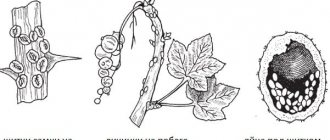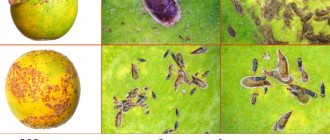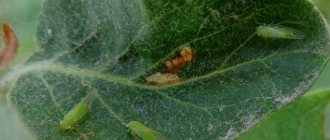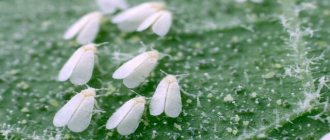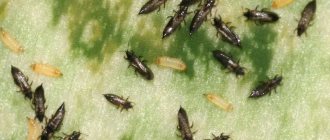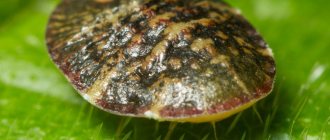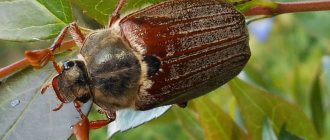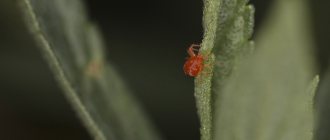Grape shoots attract the attention of many harmful insects. The plant can be eaten by leaf rollers, thrips, aphids, numerous species of mites, weevils and mealybugs. This list can also include sedentary scale insects, which settle on the grapevine and feed on its juices. As a result, the damaged parts of the plant begin to weaken and dry out, which leads to a decrease in yield. Therefore, many grape lovers are puzzled by the question of how to deal with scale insects on grapes.
How to deal with scale insects
Have you found at least one plaque of scale insects on flowers, vegetable leaves or tree branches?
Don’t hesitate - if you miss the initial stage of damage and do not take timely measures, you can lose not only the future harvest, but also the plant itself! In the garden, affected branches (foliage, bark, lichens from the trunk) must also be removed mechanically - for example, on a laying film or paper - and then the removed parts must be burned.
The most important stage in the fight against scale insects is the prevention of mass infestation - regularly and carefully inspect your plants for the appearance of insects and traces of their vital activity (egg laying, sticky honeydew), not forgetting to look on the back of the leaves and in the leaf axils.
If there are already a lot of attached scale insects, simply removing the insects and parts damaged by them will no longer be enough. Particularly damaged specimens will have to be destroyed, and chemical measures to combat scale insects will be used for neighboring plants.
Superficial one-time spraying in most cases does not give a positive effect - the shield reliably protects the insect’s body from damage. Therefore, if it is not possible to regularly wipe the plant with a material soaked in a soapy solution or insecticide, spraying treatment will definitely have to be carried out several times - at least three times, at intervals of a week, in order to guarantee the destruction of the generation of pests that reappear from the eggs of larvae.
The drug Aktara, a contact insecticide of the neonicotinoid group, whose protective effect lasts up to a month, is often recommended as an effective remedy for scale insects. The best effect will be achieved by simultaneous spraying with this substance plus root watering with its solution. In addition to Aktara, the following drugs help against scale insects:
- organic neonicotinoid pesticides that block the transmission of nerve impulses in insects (Apache, Mospilan, Tanrek, Iskra Zolotaya, Confidor, Colorado, etc.);
- juvenoids - synthetic analogues of insect hormones that disrupt their metabolism (for example, Admiral, Phasis, etc.);
- organophosphorus compounds of enteric contact action (Karbofos, Actellik, Alatar, Kemifos, Antiklesch, Novaktion, etc.).
Most of the above drugs are highly toxic, so strictly follow the dosage and technology for their use indicated on the packaging, and do not neglect safety precautions when working.
Scale insects are a dangerous and indiscriminate pest. However, if you follow preventive measures and timely use of appropriate medications, it is quite possible to free your area from this ubiquitous insect.
Without waiting for massive damage to grapes
There are several ways to deal with scale insects on grapes. Among the mechanical means, the following can be distinguished.
Critical vine damage
- In late autumn and early spring, the bushes are thinned out: dried branches and twigs are cut off.
- The bark on shrubs is freed from mosses and lichens - shelters for scale insects.
- Before planting new seedlings in the ground, the vine is carefully examined using magnifying optics. If there are signs of damage, it is better not to plant such grapes.
- You can also introduce a pest into the garden during vaccination. All cuttings are also subject to careful control.
- After the leaves fall and the plant is prepared for the winter, it would be good to treat the bush with a saturated solution of tar soap. Before this, the vine is cleared of old loose bark.
- When the first signs of insects are detected on grape leaves, small colonies of insects can be removed with a soft bristled brush or soft rag moistened with soapy water.
- Prepare the following solution: dilute diesel fuel or waste (0.5 l) in a bucket of water. You need to irrigate the grapes with an oily mixture before the buds open. Only affected bushes are treated. By doing this twice a season - the end of May and August - you can almost completely destroy the pest.
- Using alcohol (methyl alcohol) is more effective. It is capable of dissolving the durable shell covering insects and their eggs. Instead of alcohol, another alcoholic strong drink is used.
The first signs of defeat
Is it worth planting tomatoes? Yes No
The fact that it’s time to fight scale insects on grapes is indicated by brown, brown or whitish scales on the leaves, both round and oblong, often accompanied by an oily coating. The color of these scales (insect shields) depends on the type of pest.
Most often, grapes are affected by the acacia false scale insect, also known as the hazel scale insect: the back is rounded, brown or brown-red. Found on the underside of grape leaves.
Other species infect grapes less often.
- Californian scale insect - the shield is initially white, then it turns black.
- Brown scale insect - the shield is brownish, kept on the upper side of the leaves.
- Palm - the shield is transparent, whitish or grayish, lives on the underside of the leaves.
- The olive false scale is highly convex, dark brown. Lives on stems or along the veins of leaves.
Pests on grapes and their control, preventive measures
Having identified the pests, you can safely begin to destroy them.
- Scale insects have appeared on grapes, how to fight them: the main method is to irrigate the bushes with chemicals under high pressure. A strong jet helps the drugs penetrate into the depths of the plant. Thanks to this, it is possible to destroy the pests located inside. The optimal time for spraying is spring, before the first buds bloom. Preparations: Admiral, Actellik, Bi-58 Novy and others. Use according to instructions.
- Leaf roller on grapes: control measures. The most effective way to combat is the timely removal of organic residues. During the summer, it is recommended to treat the bushes with any insecticides. Later, to consolidate the result, you will need to re-irrigate with the same composition. When caterpillars are detected, it is better to use biological preparations.
- Grape cluster budworm: control methods are similar to methods for getting rid of grape budroller.
- How to get rid of ants on grapes: it is quite difficult to get rid of these insects in your summer cottage. Experienced agronomists resort to tricks and prepare a poisonous bait that destroys not only the ants that tried it, but also the fertile female. The bait is prepared as follows: mix 2 tbsp. boiling water, 1 tbsp. granulated sugar and 1/3 tsp. Boers. After natural cooling, add 1 tsp to the solution. honey The resulting composition quickly deteriorates, so it must be added every week.
- How and when to treat grapes against leaf phylloxera? Grape phylloxera is very dangerous and difficult to treat. The only effective remedy is to destroy the affected bushes. However, you can also use the drug Etafos, Actelik, Confidor Maxi to combat the leaf form of the disease. The first irrigation should be carried out during mass bud bursting, and the second during the formation of 9-12 leaves.
- Today the fight against grape mites does not cause much trouble. Modern formulations allow you to completely get rid of parasites in the shortest possible time. Before the buds open, it is recommended to treat the bush with a DNOC solution (2%), then it is advisable to treat it with a nitrophen solution. The insect settles on the back side of the leaf, so these areas should be treated most carefully. The most popular drugs for combating grape mites, which do not harm humans and do not affect the composition of the fruit: Aktelik, Neoron, Fufanom and Tevit. To consolidate the result, it is recommended to repeat the procedure after two weeks.
Every winegrower should know that such troubles are always easier to prevent than to “treat.”
Prevention measures
Why do grape leaves have holes in them? Why do they wrinkle, turn yellow, etc.? These questions worry many agronomists, especially beginners. Diseases or pests can appear in any case, but the task of the winegrower is to reduce this probability; for this it will be necessary to protect the crops, following all the rules of agricultural technology.
Protecting grapes from wasps
If for most of the summer a colony of wasps actively increases their numbers and looks for protein food to feed their offspring, then in August the insects begin to prepare for winter and their diet changes radically. The harvest of many garden crops, including grapes, is suffering from wasps, now exclusively interested in sweets. Moreover, due to the thin skin of grape berries, these pests can seriously reduce yields and negatively affect the quality of grapes.
Therefore, protecting the vineyard from wasps is a task of paramount importance for the gardener.
Coping with wasps is not easy because when the berries ripen, the use of insecticides becomes dangerous.
The best results can be achieved if you start fighting the pest in advance and use all existing methods. It is best to destroy wasp nests in the evening, when insects gather for the night. When planning to perform such a task, be sure to take all personal safety measures. The area where the pests are concentrated is treated with a fast-acting insecticide that is active against wasps.
The use of industrially manufactured and homemade traps will not help get rid of insects, but with a systematic approach it will significantly reduce their numbers. At the beginning of summer, the trap is equipped with meat or fish bait, and in August and September the vessel is filled with syrup or other sweet product. As the device is filled, it is cleaned and hung near the vineyard.
When the clusters begin to ripen, to protect the grapes from wasps, other insects and birds, they are covered with covers made of mesh or non-woven material. Such a shelter should be loose enough so as not to interfere with the filling of berries and to prevent condensation from appearing inside and the development of rot.
Scale insects and mealybugs
However, damage to the plant from this type of pest is not limited to the weakening of shoots and foliage; fungi soon develop in the habitats of scale insects and scale insects, and outbreaks of diseases dangerous to grapes appear. Where do these grape pests shown in the photo live, and how to treat the bush affected by them?
Mealybugs with a whitish, loose, waxy mass as a coating can cause serious damage to grapes. Overwintering as larvae under the bark of adult shoots and even on trellis supports, with the onset of warm weather the pests move to the green parts of the plant, to shoots and leaves, where they become adults.
Prevention and rules of agricultural technology
Scale insects, especially adult individuals, are very tenacious and are not affected by most insecticides. Therefore, fighting scale insects found in your garden is a thankless task. To avoid this, you should adhere to a number of rules.
- In autumn and early spring, the soil in the garden is dug up, fertilizers are applied, dried branches and branches are pruned, and root shoots are weeded out.
- Moss and lichen are removed from the bark; pests like to hide under them.
- It is advisable to purchase new seedlings only in specialized nurseries, and carefully examine them with a magnifying glass before planting.
- The pest can also enter the vine during grafting. Cuttings must also be carefully checked.
- Before sheltering for the winter, the vine is cleared of old bark and treated with a solution of tar soap.
Related article: Kardishah - grapes
Measures to prevent disease and pest damage
Growing grapes requires care in caring for the plant, as well as the implementation of mandatory agrotechnical techniques to protect the bushes from diseases and pests, including a number of chemical treatments.
The first preventive step to combat diseases and pests is to purchase healthy planting material. The choice of location for planting grapevines is of no small importance. It should be light and ventilated so that good air exchange prevents the development of many diseases and the appearance of pests. Mandatory compliance with the rules for caring for grape bushes will also serve as preventive measures.
This also includes protecting plants from returning spring frosts (construction of temporary shelters), installing trellises and timely tying shoots to them, correct pruning of the bush, removing weeds, loosening the soil around the trunk, mulching the soil, shallow digging between rows for the winter, and destroying heavily infected areas. and pests of plant parts.
Grape processing
For preventive purposes, grape bushes are treated with Topaz, Teovit Jet, Strobi at least 4 times:
- on young shoots after the formation of the fifth leaf;
- during the budding period;
- after flowering;
- during the formation of bunches.
After the vine has been dried, it is recommended to treat the soil with a 3% solution of ferrous sulfate or Nitrafen. You can alternate them every other year. To prevent fungal spores from getting on young shoots, the soil is immediately mulched.
They try to treat the vine against anthracnose, mildew, oidium and other fungal diseases in combination with the first foliar feeding. The drugs are added to the general solution along with fertilizers.
Video: when and how to treat grapes for diseases
It is possible to avoid major losses of grape harvest due to diseases and pests if you carefully care for them, be attentive and take preventive measures in a timely manner.
Prevention against scale insects
Among the preventive measures that can prevent the appearance of insects on grape plantings are the following:
- after harvesting in the fall and at the onset of spring, the soil is dug up, fertilizer complexes are added, dry branches and branches are cut off, and root shoots are removed;
- Before covering for the winter, the bark is cleaned of moss and lichen, subsequently treated with a solution based on tar soap.
Shchitovka
Scale insects, as well as false scale insects, are a harmful insect that can infect various plants. It poses a danger to a huge number of indoor plants. But laurel, citrus fruits, oleadra, palm trees, and amaryllis can especially suffer from it.
Scale insects (Diaspididae) are representatives of the family of homoptera insects of the suborder Coccidae. Their body has a round shape. And it is noteworthy that females have coverings on the top of their bodies in the form of wax shields.
The false scale insect is a representative of a different family (Coccidae or Lecaniidae), but belongs to the same order of coccids. Their size is much larger than that of scale insects, more precisely, from 3 to 7 millimeters. These insects do not have a shield, and the eggs and larvae are protected by the dried body of the female.
In both false scale insects and scale insects, the difference between females and males is quite large. Once the female becomes an adult, she stops moving, thus protecting the eggs attached to the surface of the plant. Males, which are not very large in size, on the contrary, are quite mobile. At first, the larvae are also very mobile, but when they join the plant, they become motionless and a waxy shield appears.
Features of the pest
Scale insects are small insects whose body length does not exceed 5 mm. The surface of the body is covered with a waxy dome-shaped shell, the color of which, depending on the species, can be white, gray, brown-black and even orange. You can distinguish a female from a male by its larger size.
On a note!
Insects are able to move only at an early age, but as the shell forms, they become motionless and settle on one plant.
Impact on garden and vegetable plants
Scale insects in the garden cause a lot of trouble for the summer resident. Initially, single tiny oval-shaped scales can be seen on the leaves or branches of plants. These are young female scale insects. The maximum size of an adult female can reach no more than five millimeters.
During the life of the females, sticky spots soon appear on the leaves.
At the same time, you can see through holes in the leaves. The damage was done by females or larvae. Soon the leaf around the hole begins to turn yellow. Then yellowness covers the entire surface of the leaf, and it falls off. The same thing happens with pine needles.
If scale insects have chosen the branches or trunks of fruit trees, then shallow cracks in the bark soon appear there.
On such branches, flowers and ovaries fall off, and they themselves later lose leaves. With an earlier attack, flowering will not occur.
If scale insects infect a plant or tree while the fruit is ripening, the fruit or vegetables become stained and die.
Along with all these troubles, pockets of sooty fungus appear on plants. The disease progresses rapidly, the plants stop growing and may die. The treatment is complex.
As for fruit trees and berry bushes, scale insects prefer to destroy seedlings or young bushes and trees. They quickly destroy a young vineyard, destroy cherry and apple trees in the gardens, feast on gooseberries in the garden, and do not allow the planting of conifers.
Reproduction of scale insects and false scale insects
Most species of scale insects reproduce by laying eggs, but there are also viviparous species. Pests live on the underside and top of leaves, shoots and trunks of plants. Only young larvae settle, sticking to various parts of the plant; adult insects are not mobile.
With severe infection, the leaves along the veins and plant trunks become covered with a coating formed from a large accumulation of scale insects. Damaged plants have stunted growth and development, leaves turn yellow and fall off prematurely.
Scale insects and false scale insects secrete a sticky liquid - honeydew, on which a sooty fungus settles, which further impairs the development of plants.
Scale insects and false scale insects damage many indoor plants: palm trees, citrus fruits, oleander, ivy, cyperus, asparagus, aucuba and others.
Adults and larvae function all year round, sucking cell sap from the plant. Damaged plants turn yellow, develop incorrectly, leaves often fall off, and young shoots dry out.
Scale insects belong to fast-growing pests. Reproduction can be either asexual or conventional. It occurs by laying eggs under the scutellum, and some species are viviparous. After hatching, the scale insect goes through several stages of development. At the initial stage, scale insects are very mobile and can quickly spread, in particular to neighboring plants.
Females are immobile, but males can even fly during their lives. However, the life cycle of the male is very short. They live only a few days, unlike females, who live for several months.
Under good conditions, more females are born; under bad conditions, more males are born. The composition of the population changes itself in such a way as to improve its mobility and move to a more favorable place for life.
Ficus leaf infected with false scale insects. Karl Magnacca
What harm does it do?
Scale insects feed on plant juices. An adult female, having acquired a shield, loses all external organs except the proboscis. Through it, she sucks out plant juices.
Having multiplied greatly, these pests take nutrients from the donor plant, as a result, it weakens, slows down in growth, and its leaves and fruits wither. Larvae cause similar damage.
Check out such grape varieties as “Chameleon”, “Vostorg”, “Veles”, “Arcadia”, “Cardinal”, “Original”, “Anyuta”, “Lora”, “Timur”, “Augustine”, “Livia” , “Rochefort”, “Amursky”, “Harold”.
In addition, insects produce a sticky liquid, the so-called honeydew or honeydew. A sooty (black) fungus develops on it, which clogs the respiratory stomata of the plant, which again leads to a deterioration in its condition.
Scale insects and its types
The peculiarity of this insect is manifested in the presence of a protective shield consisting of the remains of the larvae’s scales, glued together with its secretions. Externally, such a shell is very similar to irregularities in the surface of tree bark, which makes visual detection of the pest difficult.
The size of the insect does not exceed 5 mm, its main activity is sucking juices from plants, so it is necessary to fight scale insects in the garden, otherwise, when it multiplies en masse, the bark, fruits and ovaries on the tree will be covered with scatterings of these pests. Insects also secrete honeydew, which becomes a breeding ground for sooty fungi, causing the affected plants to gradually dry out and die.
Signs of a scale insect settlement:
- yellow spots appear on the leaves, then they turn yellow completely, curl and fall from the branches;
- the bark cracks, thin and thicker branches begin to fall off;
- the growth of the tree is inhibited, which can lead to its complete drying out and death.
Weakened trees are most susceptible to scale infestation; their appearance is also affected by excess nitrogen fertilizers, insufficient lighting of plants, lack of moisture, and dry air. Types of scale insects In dacha and garden plots in central Russia you can find several types of scale insects:
- Californian - affects fruit trees: apple, peach, plum, etc. On pear branches, the scale insect looks like small dots with colored dots or a rim.
- Comma-shaped - has a white body, similar in shape to a comma, looks like a growth on the bark of a tree up to 4 mm in size, on top of the female there is a light brown shield. During reproduction, the female lays up to 100 eggs and dies, and the nest, covered with a protective shell, winters safely even in frosts down to -30˚C. In the spring, young “vagrants” of yellow color, microscopic in size, about 0.3 mm, quickly move along the tree trunk in search of food, at this moment they are easiest to detect. Then they stick to a certain place on the bark and “grow” to it, throwing off their legs.
- Willow false shield - differs from other species in its wide and flat shell of white or gray color, size 1.8-2.5 mm. Females have a yellow-red body and lay purple-red eggs. The willow scale insect settles on currants, raspberries, gooseberries, as well as willow, bird cherry, aspen and other trees.
What does a pest look like?
Scale insects are small insects ranging in size from 0.5 to 5 mm, covered with a semicircular dome-shaped, less often oblong shell - a wax shield. They usually live on woody plants.
The color of the shield can be different, from white or gray to orange, brown or black, and depends on the species of the insect.
There are many types of scale insects and false scale insects. Gardeners unite them based on their similarity in appearance, behavior and damage. Female scale insects are larger than males, move only at an early age, until the shield has formed, and then sit motionless on the plant.
Active struggle
If scale insects are nevertheless found on grapes, not all control measures will be equally effective against insects at different stages of development. As a rule, you can get rid of larvae and young scale insects using insecticides or other toxic-cleaning agents, spraying or wiping the affected areas.
Few insecticides are effective on shielded adults or eggs covered by the shield. In this case, it is necessary to mechanically clean the affected areas.
If scale insects have tightly captured individual areas of the vine, as shown in the photo, and the measures taken to combat them do not help, you have to sacrifice not only foliage and branches, but also entire vines.
Over the centuries-old history of viticulture, many folk methods of combating this scourge, as well as a lot of effective chemicals, have been developed.
The chemical industry has developed a number of drugs to combat such insects.
- “Admiral” (emulsion concentrate)
is a highly targeted remedy for the Californian scale insect. The active substance, pyriproxyfen (juvenoid), causes changes in the development of insects, affecting their next generations. Almost safe for people and pollinating insects. Used in early spring and summer. There are restrictions on use near fish ponds. - "Aktara" is a systemic insecticide with a fairly wide spectrum of effects, including against scale insects. It is produced in water-dispersible granules or as a suspension concentrate. The active substance, thiamethoxam, works both in the soil (when watered for three days, reaching the top of the plants), and when sprayed, penetrating into the leaves within a day. It acts on pests through intestinal contact; they die within 24 hours. Used in warm, dry weather. Compatible with other insecticides.
- "Actellik" (emulsion concentrate) is
a non-systemic insecticide with a very wide spectrum of effects. The substance is pirimiphos-methyl, the effect is enteric-contact. Apply by spraying. The death of insects occurs within three hours, the protective effect lasts up to three weeks. - "Confidor Extra" (water-dispersible granules) is a systemic insecticide against sucking and gnawing insects. The substance, imidacloprid, acts in an enteric contact manner and is applied by spraying. Protection is valid for up to 30 days.
- "Bi-58 New" (emulsion concentrate)
is a systemic insecticide with a wide spectrum of effects. The damaging substance is dithiophosphoric acid, which has contact and intestinal effects. Apply by spraying twice. The protective effect lasts up to 20 days.
Important! "Bi-58" is very dangerous for fish and other aquatic animals. Not recommended for use near fishing ponds
"Bona Forte" is an insecticide used to combat scale insects, mealybugs, and whiteflies. Insects die within a few hours, protection lasts up to three weeks.
Folk remedies are not as effective as industrial chemicals; they do not allow the treatment of large vineyards, but at the same time, their use, at a higher cost, is safe for you, the grapes and the environment.
Important! "Aktara" has a hazard class 1 for bees (border protection zone 4–5 km). You can spray the affected plants with a solution of tar soap (10 g of soap per 1 liter of water) or a decoction of wood ash (300 g of ash per 1 liter of boiling water, boil for 30 minutes). The damage caused can be reduced by reducing the number of waterings of grapes, since these pests need moisture to reproduce
You can spray the affected plants with a solution of tar soap (10 g of soap per 1 liter of water) or a decoction of wood ash (300 g of ash per 1 liter of boiling water, boil for 30 minutes)
The damage caused can be reduced by reducing the amount of watering of grapes, since these pests need moisture to reproduce.
In general, scale insects are a typical pest of vineyards and are often encountered. If these are small vineyards at home or in the country, it is better to use folk remedies. They are safe for others, do not harm the grapes, but require a lot of effort.
In case of critical damage to grapes or treatment of large areas, it is better to use industrial chemicals.
Weevils or weevils
Vineyards are damaged by several species of weevils, which gnaw out the buds and leaf blades of young foliage, and their larvae can seriously damage the root system.
Adult beetles and larvae of this pest overwinter in the ground at a depth of 15 to 30 cm. Insect activity begins with the arrival of spring, when the air warms up above 10 °C. Treatment of grapes from diseases and pests, including weevils, is carried out using insecticides in the period from April to May, when the beetles are actively feeding, and also in June, when young individuals emerge from the soil. The vineyard is sprayed twice with an interval of 10 days, using chlorophos and fozalon, the soil between the rows is loosened to a depth of at least 15 cm.
Infusions and decoctions in the fight against scale insects on grapes
When deciding how to remove a pest, try folk remedies first. Herbal decoctions and infusions are distinguished by fungicidal and insecticidal properties.
Around the vineyard you need to plant companion herbs, for example, calendula
- Fern (100 g of fresh raw materials or 10 g of dry) is infused in water for a day. Then it is boiled for half an hour. The cooled and strained composition is applied to the plant. Insects do not experience a significant effect from it, but can be used for prevention purposes.
- The peel of citrus fruits with a characteristic odor repels the pest. It is enough to grind it in a meat grinder. 3 kg of the resulting raw material is poured with warm water (10 l) and infused for 24 hours. The container with the infusion is tightly sealed. Stored in a dark place for 4-5 days. Shake the resulting mixture well and strain immediately. The liquid fraction is bottled and sealed. The concentrate is stored in a dark place. Before use, 100 g of it is mixed in 10 liters of water.
- An infusion of hot pepper is used. Grind the pods to a size of 5 mm. Fill with water (1 l). Boil, simmer for an hour in a closed container, then leave for 24 hours. The finished “potion” is squeezed out and filtered. The liquid fraction is bottled and stored closed, in the dark until used. Prepare a solution from the concentrate: 100-120 g per 10 liters of water. Add green or laundry soap (40 g) to this for better fixation on the plant, after cutting it with a knife. Use the solution immediately.
- Infuse celandine (4 kg of fresh crushed plant or 1 kg of dry plant) for 2.5 days in 10 liters of water. Strain and sprinkle over the grapes.
Attention! Decoctions of plants with insecticidal properties should be used no later than two weeks before harvesting. If there are beds of strawberries and vegetables next to the grapes, then when spraying the vines they must first be covered with film
Although folk methods have a gentle effect on the plant itself, they are still used rather for preventive purposes. When a scale insect appears, and even more so when a vineyard is massively infested, insecticides must be applied immediately.
Check out articles on similar topics
- Fighting powdery mildew on grapes
- Protecting grapes from oidium
- Measures to combat grape budworm
- How to deal with aphids on grape leaves
Shield: briefly about the main thing
Scale insect is a small harmful bug
There are more than 2.5 thousand species of insects. They are brought from abroad along with goods, replenishing the domestic fauna with hitherto unknown species. They are small. The main food is the juice of grapes and other plants. Oral apparatus - proboscis. Not very mobile. Because of the shiny and smooth shell, which, like a shield, covers the body of female imagoes, they got their name. The shell protects the living organism from the effects of pesticides and weather conditions. They begin to feed with the onset of sap flow, attacking young shoots of grapes and sucking the juice from them. After the mating period, the males die. The females continue their destructive activities for several more months.
Egg clutches appear in late May. They are numerous: each contains up to 150 larvae. After a couple of weeks, caterpillars emerge from the eggs. The damage is caused by larvae and adults, affecting leaves and fruits. The shield on the “youth” is formed only after a few weeks. At this time, the larvae are vulnerable to systemic or contact insecticides.
Symptoms of infection
The sap of the plant serves as food for midges, causing the latter to lose nutrients and become weak. The growth of the grapes slows down, and the leaves and fruits begin to wither and fall off. Considering that scale insects multiply very quickly, very soon insects will be present not only on the leaves, but also on the fruits, ovaries and even the bark of the plant. Therefore, it is very important to get rid of scale insects on grapes as quickly as possible. Otherwise, it will not be possible to wait for a full harvest.
The following signs may indicate that a scale insect has settled on the grapes:
- in the place where the scale insect infests the leaf plate, a yellow spot forms, increasing as the pest sucks out the juice, subsequently the leaf becomes almost completely yellow;
- an oily coating appears on the leaves of the grapes - honeydew;
- the leaf blade curls and falls off after a while, as a result of which the grape vines become completely bare;
- the plant stops growing and may even dry out.
A photo of scale insects on grapes is presented below.
Scale on grapes
Fighting scale insects on grapes
Grape shoots attract many pests that pose a threat to the future harvest. These include scale insects on grapes. It feeds on plant juices, which leads to a decrease in yield, and sometimes to complete drying of the vine.
Fighting scale insects on grapes
How to recognize scale insects
The scale insect is a small insect 0.5-5 mm in size, with a semicircular or oblong shell. It lives on woody plants. The color of the shield is varied: white, gray, orange, brown, black - it depends on the species.
Signs of presence
The initial signs of the appearance of a pest on grapes are round or oblong scales on the foliage with an oily coating.
The places where insects appear depend on their varieties:
- the Californian species and the brown scale insect settle on the upper side of the leaf blade,
- palm prefers to live on the underside of leaves,
- the olive variety can be seen on the stems and leaf veins.
Harm from scale insects
The main damage to grapes is caused by females and larvae that feed on grape juice, taking nutrients from the plant, weakening it and slowing down its growth. As a result, the vine's foliage and fruits wither.
Insects produce a sticky liquid - honeydew (honeydew), on which a sooty fungus appears and actively develops, clogging the plant's respiratory tract, which further worsens the condition of the garden crop.
Admiral
An emulsion concentrate with the active substance pyriproxyfen has a highly targeted effect and is effective against the Californian scale insect. Leads to changes in the development of the pest. Applicable in spring and summer.
Aktara
This is an insecticidal drug with systemic exposure to the active substance thiamethoxam. It has a wide range of applications, is effective when applied to the soil, reaching the upper parts of the plant when watered in 3 days, and when sprayed, penetrating into the foliage cells within 24 hours.
Aktara has an intestinal contact effect on the scale insect, leading to their death within a day after entering the insect’s body. The drug is used in warm weather. It is compatible with other insecticides.
Aktellik
Insecticides will help get rid of pests
Actellik is a non-systemic drug with the insecticidal substance pirimifo-methyl. It has a wide range of applications. It has an intestinal contact effect on the pest, leading to death within 3 hours after use by spraying. The effectiveness of protection lasts for up to 20 days.
Confidor Extra
This is a systemic granular insecticidal preparation with the active substance imidacloprid. It has an intestinal-contact effect on the pest, entering the insect’s body through spraying. The effectiveness of protection is 30 days.
A wide-spectrum systemic insecticidal preparation with the active substance dithiophosphoric acid. Acts contact-intestinal. Apply by spraying. Maintains effectiveness for 20 days.
Traditional methods of combating scale insects
The use of folk remedies in the fight against scale insects on grapes has lower effectiveness compared to chemicals, but is safer for garden crops.
Mechanical method
Harmful insects are cleaned from grape foliage and stems using a rag or toothbrush, previously soaked in a soap, kerosene or alcohol solution. The disadvantage of the mechanical method of control is labor intensity and low efficiency, since the treatment has to be repeated several times.
Spraying
The affected grapevine is sprayed with a soap solution (10 g of tar soap per 1 liter of water) or wood ash (300 g of ash powder is boiled in 1 liter of water for half an hour).
Decoctions of celandine and fern have effective properties:
- 3 kg of celandine is infused in 10 liters of water for 24 hours, the strained solution is sprayed on the affected plantings,
- 1 kg of fern is infused in 10 liters of water for a day, then boiled for half an hour, cooled and filtered, and used for spraying.
Onions and hot peppers repel harmful insects from grape plantings:
- 4 onions are crushed, infused in 1 liter of water for 4 hours, filtered and used for spraying,
- Boil 100 g of crushed hot pepper in 1 liter of water for 15 minutes, then leave for 1 day, filter and make a working solution, calculating 10 ml of concentrate per 1 liter of water.
Grape pests: their photos and how to treat them
Grapes are a capricious crop that requires attention and proper care. The gardener's worst enemies are not asleep - grape pests, which can destroy not only the harvest of delicious berries, but the plantings themselves.
These insects not only cause damage to the plantation themselves, but also weaken the plants, thereby provoking the appearance of diseases.
A description with photographs and recommendations on how to treat the vine will help cope with insect attacks and prevent their appearance on the site.
Phylloxera
Even novice gardeners will say that the most dangerous enemy of crops is the microscopic grape aphid. A tiny yellow insect causes enormous damage to plantings and leads to the creation of quarantine zones.
Phylloxera larvae - “vagrants”, like adults, feed on the sap of plant tissues. The pest parasitizes on the roots (in European varieties) as well as on the roots and leaf blades of grapes (in American hybrids). Therefore, there are two types of pest damage:
- leaf: galls appear on the reverse side of the leaves - swellings, traces of penetration of aphid larvae into the mesophyll of tissues, leaf plates are deformed, curled, dry out;
- root: swellings (swellings) are located on the dewy roots, over time cracks appear on them, the root system rots.
The development cycle of the insect depends on the type of grape, but in any case, the defeat leads to the death of the plantings.
On a note! Aphids not only infect bushes, but also lead to the penetration of various pathogens through tissue damage.
Without timely control measures, the vineyard may completely die within 3-6 years. Affected bushes are uprooted.
Methods for exterminating and preventing the appearance of the pest:
- catarrhization of bushes (removal of surface roots);
- treatment with preparations “Kinmiks”, “Aktellik”, “Fastak”.
It is recommended to plant phylloxera-resistant varieties (European) in the plots, purchasing seedlings only in specialized nurseries.
Ticks
Another insidious enemy of grape plantations is various types of mites. Voracious and prolific insects parasitize the leaves of the crop, leading to drying out and death of plants.
Most often found on landings:
- Felt mite (itching) - lives on the back of the leaf on grapes and feeds on the sap of the plant. Depressed spots form on the leaves, first a white and then a brown fluffy coating appears. With a large number of felt mites, the leaf plates become like lumpy felt;
- The grape spider mite is a microscopic (up to 0.4 mm) yellowish-green insect. A sign of damage is a white-yellow coating on the back of the leaf;
- Leaf mite is another parasite whose activity also leads to deformation and drying of leaves. In addition to the leaves, during wintering it damages the buds, which is why twisted, weak shoots are noticeable in the spring.
To combat ticks, special insecticidal preparations are used - acaricides, since traditional means are powerless against arachnids.
Among them:
- "Omite";
- "BI-58";
- "Neoron";
- "Aktellik".
Before the buds open, it is recommended to treat the grapes against pests and diseases with a sulfur-lime solution (5%), chemicals “Karate” and “Fozalon”.
Scale insects and false scale insects
Various types of scale insects and false scale insects cause enormous damage to grape plantings. There are more than two thousand species of these insects, of which the following are most often found on crops:
- olive;
- palm;
- brown;
- Californian;
- acacia
Insects are very small (up to 3-4 mm), with a shield (shell) of gray, black, orange, brown color. Signs of the appearance of a pest are the formation of scales with an oily coating on the foliage.
Larvae, like adults, feed on plant sap. This leads to wilting of foliage, shoots, and ovaries. The larvae secrete honeydew, a sticky liquid on which colonies of sooty fungus form.
Plaque clogs the stomata on the leaves, which leads to disruption of metabolic processes.
Scale insects are tenacious and resistant to various chemicals, so it is advisable to prevent this pest from appearing on the site. If signs of insects are noticed, then insecticides are used to spray the vines:
- "Aktara";
- "Admiral";
- "Confidor Extra";
- "Bi-58".
In small areas of the vineyard, they practice washing scale insects off the leaves using a rag soaked in kerosene or soap solution. Gardeners treat the vine with products prepared according to folk recipes (infusions of celandine, fern, onions, hot pepper), but they are effective only as preventive measures.
Wasps
Losses from wasp invasion during the ripening period of sweet berries can reach 50-60%.
In the garden, entire colonies of striped insects form, which in May-July first feed on protein foods, and towards the end of summer they switch to berries. Insects pierce the skin of the grapes and suck out the sweet juice.
Often, wasps even get inside the berry, and then there is a high risk of the pest getting into a person’s mouth (he feasted on grapes and, without noticing, swallowed a wasp).
The plantation needs to be protected and methods to combat wasps need to be studied (see video):
- destroy wasp nests in the garden;
- set traps (baits with sweet syrup), those who have already fought with whiteflies in their area definitely have experience in making such traps;
- use liquid smoke, the Sochva preparation, to scare away;
- add insecticides to baits.
Attention! Spraying insecticides in the fight against wasps is not allowed, as the berry clusters accumulate toxic substances.
Leaf rollers
Tiny butterflies that flutter over grape plantations can be dangerous pests. Most often, three types of leaf rollers attack plantings:
- Grozdevaya is a butterfly with brown leaves. Its larvae are large green caterpillars that destroy everything: flowers, leaves, ovaries, young berries. You can recognize its presence by the web with which the pest entangles bunches of grapes.
- Vine - the adult (butterfly) has brown wings with two dark stripes. Larvae - brown-green caterpillars appear in the spring, devouring buds, young leaves, shoots;
- The biennial is a yellow butterfly with dark stripes on the wings. The larvae destroy flowers, ovaries, and fruits.
Crop losses from leaf rollers amount to 70-80%. When is it necessary to spray grapes against pests? Since butterflies begin to emerge in the spring, it is necessary to pre-treat the vineyards with insecticides:
- "Fufanon";
- "Inta-Vir";
- "Arrivo";
- "Decis".
During budding and flowering, it is recommended to spray the bushes with solutions of Tsimbusha and Rovikurt (dosages strictly according to the instructions).
Marble Khrushchev
Unlike the May beetle, the marbled beetle has a spotted coloration of the elytra (white patches on a brown background). The danger is posed by beetle larvae - large, up to 5-7 cm, whitish-dirty in color with a dark head. They parasitize on the roots of bushes, destroying grape plantings of any age.
The life cycle of beetles is long, and if in the first year the larvae are not dangerous to plants, then from the second year they begin their invasions, destroying seedlings, roots, and young shoots.
Fighting methods:
- preventive etching of soil using Decis, Aktara, Aktellik;
- introducing granular insecticides into the soil (Grom-2, Bazudin);
- regular digging of soil on the site;
- inspection of compost and manure heaps in which beetle caterpillars overwinter.
Willow woodborer (odorous)
The pest got its name because of the unpleasant odor emitted by the larvae. Adults are large, gray, with a large number of stripes and dots on the wings of the butterfly. Reddish woodworm caterpillars gnaw out long (up to 70-100 cm) passages in grape shoots, which is why the crop dries out and dies. A colony of larvae overwinters in shoots.
On a note! Most often, woodworms lay eggs on old grapevines.
The insect leaves characteristic damage - holes in the shoots, peeling bark, discharge.
In order to cure damaged bushes and destroy caterpillars, solutions of the drugs “Karbofos”, “Aktellik”, “Diazinon” are injected into the shoots. Birds provide good help to gardeners: tits, magpies, woodpeckers, rooks, which instantly destroy the pest.
pad
If a whitish, cotton-like fluff is noticed on the shoots of grapes, it means that the grape bud has settled on the vine. This small pest parasitizes the leaves and shoots of the crop, sucking out the juice.
The fluff protects the clutches of insect eggs that the female lays in the spring. Its fertility is amazing: up to 2-2.5 thousand eggs per season. The pest weakens the shoots, the plants' immunity is weakened, and yields decrease.
For control, grape vines are treated in the spring, before the beginning of the growing season, with the drug “DNOC” (1%), as well as with the agents “BI-58” and “Antio”.
Grape pests are insidious and dangerous, and only proper prevention and compliance with the rules of crop care can prevent crop losses and destruction of plantings.
Natalia Severova
Source: https://sovusadba.ru/vrediteli-i-bolezni/obrabotka-vinograda-ot-vrediteley-i-bolezney-vesnoy-i-letom.html
Grape aphid or phylloxera
An extremely dangerous pest for rootstock and European grape varieties is the grape aphid, which causes damage to plantings in all existing forms, be it larvae, nymphs, winged and soil insects.
Appearing in Europe in the mid-19th century, this pest caused devastating damage to the most famous vineyards, calling into question the cultivation of this crop in France.
During the season, aphids give 7-8 generations, as a result, plants infected with the root form of phylloxera noticeably weaken, their root system turns out to be underdeveloped, and without treating the grapes from diseases and pests, the vine dies within a few years. This form can only be dealt with by completely removing the affected bushes. The leaf form, characterized by the appearance of galls containing aphid eggs on the back of the leaves, is usually detected in the second year.
Since this dangerous pest is a quarantine pest, control measures include preventing the spread of aphids, as well as using phylloxera-resistant rootstocks. Actelik, Dilor, Confidor Maxi and Etafos are used against the leaf form. The first treatment is carried out when the buds bloom en masse, and the second at the stage when the shoots already have 9–12 leaves.
Leaf rollers and other green grape pests
Caterpillars of grape moths, grape moths and biennial leaf rollers feed on buds, delicate flowers and buds of grapes, as well as ovaries and already ripening berries. As a result, the affected parts of the vine rot or dry out and die. Grape bushes are also parasitized by cutworm and moth caterpillars, feeding on buds and leaves. Without proper attention, serious damage to the green parts of the plant can be caused by the leaf miner, whose larvae developing in the leaf tissue feed on it and make winding passages.
Read also: Zarnitsa grapes: description of the variety, cultivation features
To protect the crop from leaf rollers and cutworms, treatment of grapes against diseases and pests with insecticides is carried out during the period when butterflies emerge.
If eggs and caterpillars are found on the grapes, it is important to carefully remove the damaged parts of the plant, preventing the pests from spreading. You can protect the crop through three successive treatments with Fozalon, Ambush, Sumicidin or modern biological products.
Leaf rollers
“What a beautiful moth!” - we think, looking at the leaf roller fluttering over the grapes. Three types of leaf rollers attack grapes, and all of them are a headache for gardeners.
The grape leaf roller is a small butterfly with a wingspan of 2-3 cm. The color of the wings is dark brown with a copper sheen and two oblique dark stripes. The caterpillars change color from gray to dark green and brown. They appear after hibernation during the period of swelling of the buds and eat them, and then attack everything: shoots, leaves, flowers and even berries. All that remains is a gnawed “skeleton”. The leaf roller's natural enemy is scorching heat.
The biennial leafroller is a butterfly 1.2-1.5 cm long. The wings are light yellow with a trapezoidal black-brown stripe. The caterpillar has a black head and body, the color of which changes from light green to deep red. First, the larvae eat the buds and ovaries, and then feast on the berries. During the season, insatiable leaf rollers destroy up to 80% of the crop.
Bunch leaf roller. It can be identified by its olive-brown wings and a mottled pattern on them. The wingspan of the butterfly is only 1-1.3 cm. The caterpillar is light green, very mobile and voracious. It feeds on everything: buds, flowers, ovaries, green (unripe) berries. Along the way, it entwines the grapes with a sticky web, thanks to which it reveals itself. For the winter it goes into the bark, cracks in trellises and any perennial wood.
Measures to combat leafworm:
|
Varieties resistant to leaf roller: Moldova, Pamyati Negrulya, Dekabrsky, Frumoasa Albe.
Preventive actions
Such measures are more preventive and will help avoid infestation of the plant with pests.
- In late autumn and early spring, the soil on the site is deeply dug up, applying fertilizers and cutting off dried branches and twigs. They also get rid of root growth.
- The grape bark is cleared of moss and lichen, where scale insects usually prefer to hide.
- For planting, it is better to use seedlings from specialized nurseries, having carefully examined them with a magnifying glass.
- When covering the vine for the winter, it is cleared of old bark and treated with a solution based on tar soap.
Sources:
https://ampel-nord.ru/vyrashhivanie-vinograda/zashhita-vinograda/vrediteli-vinograda-shhitovki-i-lozhnoshhitovki/ https://agronomu.com/bok/4020-kak-borotsya-so-schitovkoy-na- vinograde.html https://apest.ru/shchitovka/shchitovka-na-vinograde/


